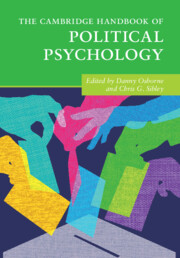Book contents
- The Cambridge Handbook of Political Psychology
- The Cambridge Handbook of Political Psychology
- Copyright page
- Dedication
- Contents
- Figures
- Tables
- Contributors
- Part I Foundations of Political Psychology
- Part II The Politics of Intergroup Attitudes
- Part III Contemporary Challenges to Democracy
- Part IV Diversifying Perspectives in Political Psychology
- 37 Political Psychology in the Global South
- 38 Political Psychology in the Arab Region
- 39 Critical Perspectives in Political Psychology
- 40 Rethinking Group Dynamics
- 41 Two Sides of the Same Coin
- Index
- References
38 - Political Psychology in the Arab Region
A Commentary on Navigating Research in Unstable Contexts
from Part IV - Diversifying Perspectives in Political Psychology
Published online by Cambridge University Press: 17 February 2022
- The Cambridge Handbook of Political Psychology
- The Cambridge Handbook of Political Psychology
- Copyright page
- Dedication
- Contents
- Figures
- Tables
- Contributors
- Part I Foundations of Political Psychology
- Part II The Politics of Intergroup Attitudes
- Part III Contemporary Challenges to Democracy
- Part IV Diversifying Perspectives in Political Psychology
- 37 Political Psychology in the Global South
- 38 Political Psychology in the Arab Region
- 39 Critical Perspectives in Political Psychology
- 40 Rethinking Group Dynamics
- 41 Two Sides of the Same Coin
- Index
- References
Summary
Many Arab countries have experienced deep social, political, and psychological struggles and transformations, yet political psychological analyses of the region remain scarce. This chapter provides a brief overview of the historical context, present, and future directions of the field. Some challenges are epistemological and theoretical, including culturally decontextualized literature and under-theorised topics. Other challenges lie in research production, with difficulties in acquiring qualified researchers, institutional support, training, representative samples, and elaborate, culturally relevant approaches. The final set of challenges are social, political, and ethical in nature, especially pertinent in unstable and conflict-ridden settings, where sensitive questions may pose risks to the community and researchers, trigger suspicion, and highlight researchers’ positionalities and biases. Despite these challenges, however, growing recognition of critical, indigenous, innovative, and collaborative psychology points to promising signs for the future of political psychology in the Arab region, much like the rest of the Global South.
- Type
- Chapter
- Information
- The Cambridge Handbook of Political Psychology , pp. 624 - 639Publisher: Cambridge University PressPrint publication year: 2022
References
- 2
- Cited by

